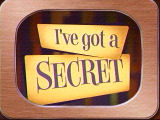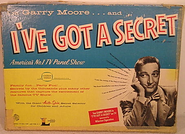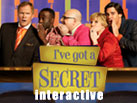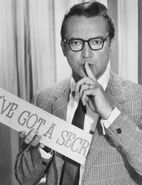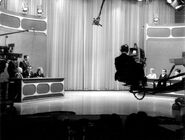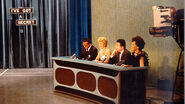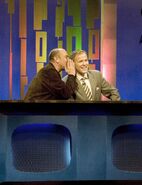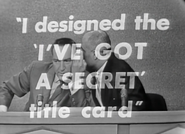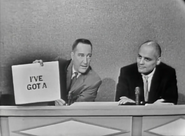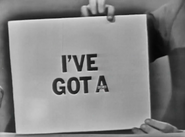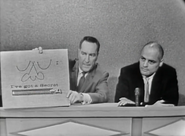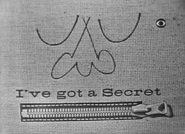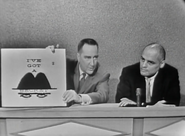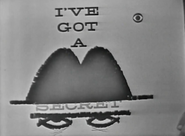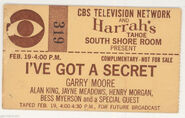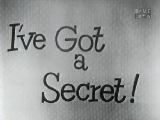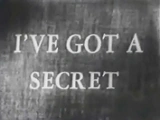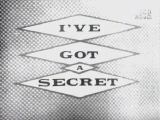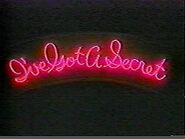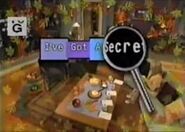| Hosts | |
| Garry Moore (1952–1964) Steve Allen (1964–1973) Bill Cullen (1975-1976) Stephanie Miller (2000–2001) Bil Dwyer (2006) | |
| Sub-Hosts | |
| Dennis O'Keefe Hal March Bill Cullen Henry Morgan Don McNeil Betsy Palmer Bill Goodwin Steve Allen Arthur Godfrey | |
| Announcers | |
| John Cannon (1952–1967) Bern Bennett (sub) Johnny Olson (1972–1973, 1976) | |
| Broadcast | |
| CBS Primetime: 6/19/1952 – 4/3/1967Syndication (Weekly): 9/11/1972 – 6/4/1973 (reruns aired until 9/9/1973)Pilot: 9/28/1975 CBS Primetime: 6/15/1976 – 7/6/1976Oxygen (Daily): 2/2000 – 2001GSN (Daily): 4/17/2006 – 6/9/2006 | |
| Packagers | |
| Mark Goodson/Bill Todman Productions (1952–1976) Pearson Television/Paramount Television (2000–2001) Burt Dubrow Productions/Get Real Entertainment (2006) | |
| Distributor | |
| Firestone Program Syndication Co. (1972-1973) | |
I've Got a Secret was a classic panel show where contestants had a hidden secret (hence the title) which is usually a stunt or occupation.
Regular Panelists[]
- Bill Cullen
- Faye Emerson
- Jayne Meadows
- Betsy Palmer
- Bess Myerson
- Richard Dawson
- Henry Morgan
- Pat Collins
- Elaine Joyce
- Jim J. Bullock
- Jason Kravits
- Amy Yasbeck
- Teri Garr
- Billy Bean
- Frank DeCaro
- Jermaine Taylor
- Suzanne Westenhoefer
Gameplay[]
A panel of four celebrity guests faced one contestant or a group of contestants. Each contestant that appeared had a weird, fabulous, laughable and/or unusual secret. When the game started after the contestant came out & introduced himself/herself, the contestant whispered the secret into the host's ear, and the audience in studio and at home was shown the secret. After that, the host would give a clue to the panel concerning the secret; that's when the questioning began.
Each panelist one at a time in turn asked yes or no questions to the contestant in an attempt to guess the secret. The panelist in control would have an unmentioned amount of time to question the contestant. When the time was called by the producers and the panelist in control did not guess the secret, the next panelist in line would do the questioning. The process went on until either the secret was guessed, or until the entire panel questioned the contestant.
After the game, the contestant would talk about his/her secret via the host's interview and sometimes a video/movie clip or demonstration would be shown.
Guest Rounds[]
Also on the show, celebrity guests played the game themselves. At the start of each show, the celebrity guest in question would introduce himself/herself followed by saying, "…and I've Got a Secret." The game was pretty much the same as with the regular contestants, but sometimes the panel would be off-stage in preparation of the game. Sometimes the secrets would be a personal secret, or something they were going to do that day.
By the 1960s, celebrity secrets were replaced with the guest playing an alternate game with the panel.
Payoffs[]
On some versions, contestants would win money for each panel that doesn't know the secret, and sometimes a grand prize for stumping the panel.
- 50s Version – Each panelist stumped was worth $20 to the contestant for a top prize of $80. Originally it was $10 per stumped panelist, and each panelist took two turns instead of one.
- 2000 Version – In the Oxygen revival, the contestant won $200 for each stumped panelist, and stumping the panel was worth a total of $1,000.
- GSN Version – Stumping the panel in this version was worth $1,000 and dinner for two in Beverly Hills. Failure to do so won an unmentioned consolation prize.
Notable Contestants[]
- Colonel Harland Sanders – His secret was that he started his long-running restaurant chain Kentucky Fried Chicken (KFC) using his first security check.
- Philo T. Farnsworth – The inventor of electronic television.
- Pete Best – He used to be one of the Beatles.
- Samuel Seymour – He was the last surviving eye witness to Abraham Lincoln's assassination (he was 5 years old when it happened).
International Versions[]
An Australian version of the show was produced and aired in Brisbane on QTQ Channel 9 from 1967 to 1973. It was hosted by newsreader Don Secombe, and like its American inspiration, featured regular celebrity panelists including Ron Cadee, Babette Stevens and Joy Chambers (future wife of Australian game show impresario Reg Grundy) .
A different Australian version aired in Melbourne in 1956, with Eric Pearce as host. It debuted during the first week of television programming in that city and opening night for television station HSV 7 (November 4) with American actress, Jean Moorhead, as a guest panellist. During its run, it featured regular panelists such as Olive Wykes, Shirley Cecil, John Frith, Freddie Bowler and Jack Dyer. It is not clear when that particular version ended, but it was still running in 1958. It is not known if any kinescopes exist of this version.
A Japanese version aired on NHK from 1956 to 1967 called My Secret, hosted by Keizo Takahashi.
French network TF1 aired J'ai un Secret between 1982 and 1983, hosted by Pierre Bellemare.
A British version aired on BBC1 in 1988, hosted by Tom O'Connor.
Merchandise[]
A Board game was manufactured by Lowell in 1956. (NOTE: Host Garry Moore is on the box cover of the game.)
During the 2006 GSN era, there was an interactive game where viewers were able to play along with the show through its website.
Gallery[]
Press Photos[]
George Olden[]
Tickets[]
Logos Over The Years[]
Carsey-Werner's unsold IGAS revival[]
In 1992, The Carsey-Werner Company acquired the rights to the format as they originally planned to aired it in the Fall of 1993 (and quite possibly pair it up with the short-lived, Bill Cosby revival of You Bet Your Life in Syndication) at the time. However, plans for it fell through at the last minute later on in its lifespan. Additionally, this was the only proposed revival of IGAS in history to have not named a permanent host and its four panelists for the show at all.
Spinoffs[]
Figure it Out - a kid's version similar to I've Got a Secret except the "Secret" was on a game board. The panel still ask yes or no questions and the contestants win prizes instead of small cash.
Taping Locations[]
New York City, NY (1952–1967, 1976)
Los Angeles, CA (1972–1973, 2000–2006)
Rating[]
Music[]
Main (1952) – "Plink, Plank, Plunk!" by Leroy Anderson
Main (1961) – Theme from A Summer Place by Max Steiner
Main (1962) by Norman Paris
Main (1972) – "This Could Be the Start of Something" by Steve Allen (Other cues by Edd Kalehoff)
Main (1976) by Score Productions (Later used on Second Chance)
Main (2000) by Tim Mosher & Stoker
Main (2006) by Alan Ett & Scott Liggett
Additional Page[]
I've Got a Secret/Quotes & Catchphrases
Links[]
I've Got a Secret Online
I've Got a Secret @ Tim's TV Showcase
Rules for I've Got a Secret
"Official" website of the 2000-2001 Oxygen version of IGAS
IGAS Carsey Werner Website
'Secret' Comeback: I've Got a Secret





